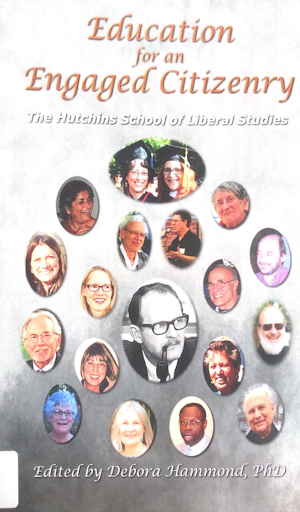Education for an Engaged Citizenry
The Hutchins program “emerged during the tumultuous period of the late 1960s and, like other experimental programs established during this time, it sought to address what many saw as the limitations of the dominant approach to higher education.”
A former student explains, “All of this reading, writing and being in seminars with others ideally helps us to change our lives and put forth a more ideal way of living. With all the problems we face in today’s world-there must be something each of us can do.” In the chapter “Hidden Treasures: Deepening the Joy of Learning” by Meredith Caplan, Caplan talks about her experience in Hutchins and how she took what she learned and uses it in her classrooms so that her students can focus on engaged citizenry. She talks about the benefits of being part of Hutchins and how being in the classrooms allows you to share ideas with others and come up with solutions for world issues.
Dr. Debora Hammond, from Sonoma State’s Hutchins School of Liberal Studies published her book, “Education for an Engaged Citizenry” which consists of works from previous and new faculty celebrating the 50th anniversary of Hutchins. This book is filled with different ideas and information about what Hutchins is and how it has turned into one of the most successful schools in America.
This school of Liberal Arts was named after Robert Maynard Hutchins who was President and Chancellor of the University of Chicago where he “promoted interdisciplinary initiatives in teaching and research, and emphasized the importance of active student engagement in the learning process, through Socratic dialogue and inquiry.” Dr. Hutchins was a founding father of this school and was the initial inspiration along with Paulo Freire who “provided the pedagogical framework, offering a model of agency that empowers students, both in the classroom and in the world at large.”
In the book, Dr. Hammond explains what the Hutchins School is, how it began and includes some of the founding staff of Hutchins, who share their struggles and successes while working in the program over the years. In order to really understand what Hutchins is and how it has evolved to what it is now, it is important to have some context and perspectives from both previous and more recent faculty.
Throughout the book the faculty included, talk about the objectives of the program and what they aim to do. “Hutchins professors make every effort to move responsibility for learning from the teacher to the students. Professors facilitate discussions, rather than tell students what or how to think.” This was definitely something that stood out because it shows just how different Hutchins is from other schools on campus. It’s probably one of the best things about being part of Hutchins, because the students play an important role in the classrooms, as they are encouraged to be active in their learning process.
Having a professor on campus who publishes a book is amazing, not only for the professor but also for the school, as it strives to give its students the best education possible from some of the best faculty. This book definitely celebrates the Hutchins programs and allows its reader to learn and understand just exactly what they stand for and what they strive to do. It is important to know more about the different programs and departments offered on campus and this book gives an insight on one of many opportunities for students.
Celebrating the anniversary, Dr. Hammond includes work from alumni who share their reflections of their time in Hutchins. These are very special as it includes some thoughts and experiences of alumni who went through the process and how they have used their knowledge and things they gained in their careers and everyday lives. In the chapter “Hutchins: A Gallery Walk” written by John Esterle, he says “Hutchins was not just a positive undergrad experience for me, it was a set of values and perspectives and processes that I internalized; a thread that I ended up weaving through my life in different ways.” This shows just how much students can benefit from being part of Hutchins and how it not only teaches its students about their education and careers, but gives them valuable life skills.
Caplan also writes, “Being in conversation with others who may not agree with all our ideas, exchanging ideas and thoughts with each other is an important contribution in the process of bringing about positive change.” This shows that Hutchins students are able to use their skills in their future careers to try to bring positive change to the world. Including these chapters written by alumni is a great way for us to learn more about how Hutchins teaches its students differently and how they use what they learn to bring positive change in society. We congratulate Dr. Hammond for publishing this book filled with knowledge and personal experiences, and the Hutchings School of Liberal Studies as they celebrated their 50th Anniversary.

Author: Guest Blogger



